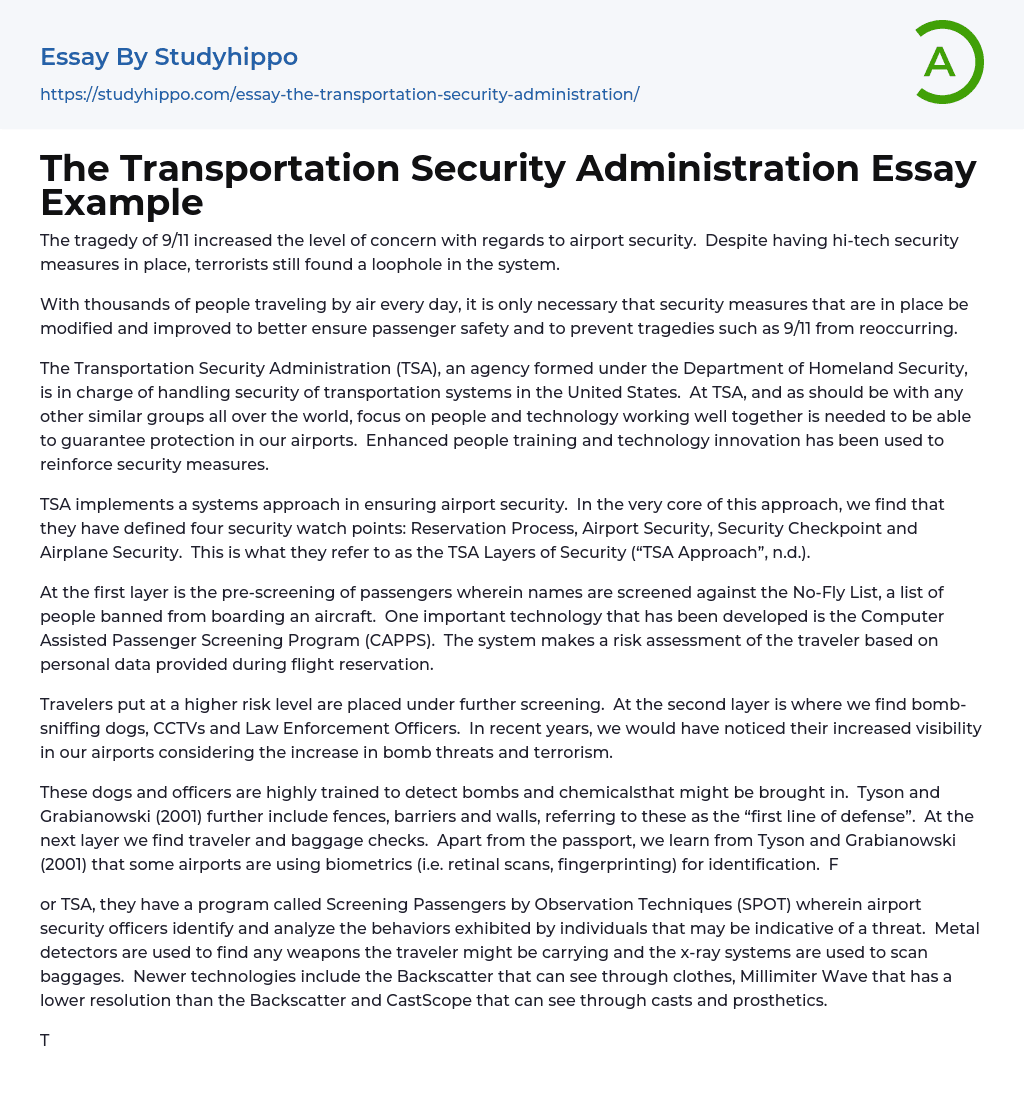The tragedy of 9/11 increased the level of concern with regards to airport security. Despite having hi-tech security measures in place, terrorists still found a loophole in the system.
With thousands of people traveling by air every day, it is only necessary that security measures that are in place be modified and improved to better ensure passenger safety and to prevent tragedies such as 9/11 from reoccurring.
The Transportation Security Administration (TSA), an agency formed under the Department of Homeland Security, is in charge of handling security of transportation systems in the United States. At TSA, and as should be with any other similar groups all over the world, focus on people and technology working well together is needed to be able to guarantee protection in our airports. Enhanced people training and t
...echnology innovation has been used to reinforce security measures.
TSA implements a systems approach in ensuring airport security. In the very core of this approach, we find that they have defined four security watch points: Reservation Process, Airport Security, Security Checkpoint and Airplane Security. This is what they refer to as the TSA Layers of Security (“TSA Approach”, n.d.).
At the first layer is the pre-screening of passengers wherein names are screened against the No-Fly List, a list of people banned from boarding an aircraft. One important technology that has been developed is the Computer Assisted Passenger Screening Program (CAPPS). The system makes a risk assessment of the traveler based on personal data provided during flight reservation.
Travelers put at a higher risk level are placed under further screening. At the second layer is
where we find bomb-sniffing dogs, CCTVs and Law Enforcement Officers. In recent years, we would have noticed their increased visibility in our airports considering the increase in bomb threats and terrorism.
These dogs and officers are highly trained to detect bombs and chemicalsthat might be brought in. Tyson and Grabianowski (2001) further include fences, barriers and walls, referring to these as the “first line of defense”. At the next layer we find traveler and baggage checks. Apart from the passport, we learn from Tyson and Grabianowski (2001) that some airports are using biometrics (i.e. retinal scans, fingerprinting) for identification. F
or TSA, they have a program called Screening Passengers by Observation Techniques (SPOT) wherein airport security officers identify and analyze the behaviors exhibited by individuals that may be indicative of a threat. Metal detectors are used to find any weapons the traveler might be carrying and the x-ray systems are used to scan baggages. Newer technologies include the Backscatter that can see through clothes, Millimiter Wave that has a lower resolution than the Backscatter and CastScope that can see through casts and prosthetics.
Tyson and Grabianowski (2001) identify more baggage screening systems. A Computer Topography (CT) Scanner is used to scan suspicious bags. Larger x-ray systems such as mobile and fixed site x-ray systems are used for cargos. For lockers and unattended baggages, biological/chemical sniffers are sometimes used to detect traces of chemicals that may be used to make bombs.
A proposed machine is the Trace Portal that is also used to detect traces of chemicals. Even biological warfare is now a concern making the presence of such measures as necessary
as the conventional methods of security. Once onboard, the final layer of security is practiced.
As mentioned above, people and technology should be able to work together to provide the highest security possible. If all else fails, apart from hardened cockpit doors, we find flight deck officers and crew highly-trained in handling attacks. Air marshals, federal agents disguised as civilians, are also sometimes onboard a flight.
With people, methods and high technology working together to combat terrorism and reinforce airport security, one should be reassured enough when traveling by air. But despite the risks having been lowered, we should know that dangers cannot completely be eliminated. We can only do our part as well, be aware, be informed and contribute to the systems in place by following regulations and reporting suspected threats, not only to ourselves, but to fellow travelers as well.
References:
Tyson, J., & Grabianowski, E. (June 20, 2001). "How Airport Security Works". Retrieved August 2, 2007, from http://www.howstuffworks.comairport-security1.htm.
TSA Approach. Retrieved August 2, 2007, from http://www.tsa.gov/approach/index.shtm.
- Federal government essays
- Armed Forces essays
- Confederate States Of America essays
- Federal Government Of The United States essays
- Fourteenth Amendment To The United States Constitution essays
- Governance essays
- Parliament essays
- Politics essays
- Jurisdiction essays
- Bureaucracy essays
- Separation Of Powers essays
- Congress essays
- President essays
- United States Congress essays
- Non-Commissioned Officer essays
- Appeal essays
- Revenge essays
- Corporate Governance essays
- Public Service essays
- Income Tax essays
- Supply essays
- Red Cross essays
- Democracy essays
- State essays
- Liberty essays
- Absolutism essays
- Reform essays
- Republic essays
- John Marshall essays
- Bourgeoisie essays
- Developed Country essays
- Elections essays
- International Relations essays
- Left-Wing Politics essays
- Monarchy essays
- Political Corruption essays
- Political Party essays
- Political Science essays
- Sovereign State essays
- United Nations essays
- World Trade Organization essays
- Contras essays
- Dictatorship essays
- Foreign policy essays
- Monarch essays
- Corruption essays
- Foreign essays
- Democratic Party essays
- European Union essays
- President Of The United States essays




